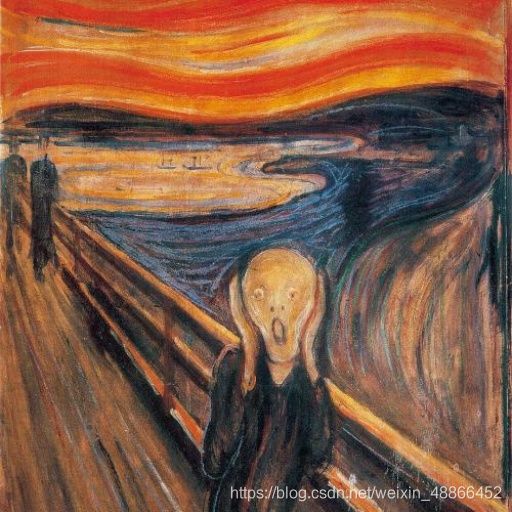风格迁移StyleTransfer和Pytorch实现
风格迁移及Pytorch实现
风格迁移,就是利用算法学习一幅画的风格,然后再把这种风格应用到另外一张图片上。
本篇文章会介绍其原理,并使用Pytorch实现。
在卷积中,浅层特征更具体,深层特征则更抽象);从风格角度来说,浅层特征则记录着颜色纹理等信息,而深层特征则会记录更高级的信息。
主要方式则是,随机一张图片,通过优化内容损失和风格损失,改变该图,使其内容接近内容图片,风格上接近风格图片。
内容损失:直接计算特征图的欧式距离;
风格损失:计算特征图的格拉姆矩阵的欧式距离
格拉姆矩阵的计算方式:
def get_gram_matrix(f_map):
n, c, h, w = f_map.shape
if n == 1:
f_map = f_map.reshape(c, h * w)
gram_matrix = torch.mm(f_map, f_map.t())
return gram_matrix
else:
raise ValueError('批次应该为1,但是传入的不为1')
将特征图reshape,将宽高的维度合在一起,然后计算其与自身转置的矩阵乘法即可。
迁移出预先训练好的VGG19的模型。并输出五个不同维度的特征图。
from torchvision.models import vgg19
from torch import nn
from torchvision.utils import save_image
import torch
import cv2
class VGG19(nn.Module):
def __init__(self):
super(VGG19, self).__init__()
a = vgg19(True)
a = a.features
self.layer1 = a[:4]
self.layer2 = a[4:9]
self.layer3 = a[9:18]
self.layer4 = a[18:27]
self.layer5 = a[27:36]
def forward(self, input_):
out1 = self.layer1(input_)
out2 = self.layer2(out1)
out3 = self.layer3(out2)
out4 = self.layer4(out3)
out5 = self.layer5(out4)
return out1, out2, out3, out4, out5
将图片直接定义为网络参数,来训练它。这里直接从原始内容图训练,也可以使用白噪声。
class GNet(nn.Module):
def __init__(self, image):
super(GNet, self).__init__()
self.image_g = nn.Parameter(image.detach().clone())
# self.image_g = nn.Parameter(torch.rand(image.shape)) # 也可以初始化一张白噪声训练
def forward(self):
return self.image_g.clamp(0, 1) # 为了限定数值范围。
定义加载图片函数:
def load_image(path):
image = cv2.imread(path) # 打开图片
image = cv2.cvtColor(image, cv2.COLOR_BGR2RGB) # 转换通道,因为opencv默认读取格式为BGR,转换为RGB格式
image = torch.from_numpy(image).float() / 255 # 数值归一化操作
image = image.permute(2, 0, 1).unsqueeze(0) # 换轴,(H,W,C)转换为(C,H,W),并做升维处理。
return image
需要使用图片需要保持形状一致
首先加载内容图片和风格图片,再实例化VGG19网络和图片,图片直接从原内容图开始训练。
实例化优化器和损失函数。
image_content = load_image('c.jpg').cuda()
image_style = load_image('s.jpg').cuda()
net = VGG19().cuda()
g_net = GNet(image_content).cuda()
optimizer = torch.optim.Adam(g_net.parameters())
loss_func = nn.MSELoss().cuda()
计算风格图片的输入VGG19的输出,并得到其格拉姆矩阵。
s1, s2, s3, s4, s5 = net(image_style)
s1 = get_gram_matrix(s1).detach().clone()
s2 = get_gram_matrix(s2).detach().clone()
s3 = get_gram_matrix(s3).detach().clone()
s4 = get_gram_matrix(s4).detach().clone()
s5 = get_gram_matrix(s5).detach().clone()
计算内容图片输入VGG19的输出
c1, c2, c3, c4, c5 = net(image_content)
c1 = c1.detach().clone()
c2 = c2.detach().clone()
c3 = c3.detach().clone()
c4 = c4.detach().clone()
c5 = c5.detach().clone()
训练该图片。
i = 0
while True:
"""生成图片,计算损失"""
image = g_net()
out1, out2, out3, out4, out5 = net(image)
"""计算分格损失"""
loss_s1 = loss_func(get_gram_matrix(out1), s1)
loss_s2 = loss_func(get_gram_matrix(out2), s2)
loss_s3 = loss_func(get_gram_matrix(out3), s3)
loss_s4 = loss_func(get_gram_matrix(out4), s4)
loss_s5 = loss_func(get_gram_matrix(out5), s5)
loss_s = 0.1*loss_s1 + 0.1*loss_s2 + 0.6*loss_s3 + 0.1*loss_s4 + 0.1*loss_s5
"""计算内容损失"""
loss_c1 = loss_func(out1, c1)
loss_c2 = loss_func(out2, c2)
loss_c3 = loss_func(out3, c3)
loss_c4 = loss_func(out4, c4)
loss_c5 = loss_func(out5, c5)
loss_c = 0.05 * loss_c1 + 0.05 * loss_c2 + 0.15 * loss_c3 + 0.3 * loss_c4 + 0.45 * loss_c5
"""总损失"""
loss = 0.5*loss_c + 0.5*loss_s
"""清空梯度、计算梯度、更新参数"""
optimizer.zero_grad()
loss.backward()
optimizer.step()
print(i, loss.item(), loss_c.item(), loss_s.item())
if i % 1000 == 0:
save_image(image, f'{i}.jpg', padding=0, normalize=True, range=(0, 1))
i += 1
分别计算风格损失和内容损失,然后求得总损失,优化该损失。
基本迭代一千次即可出效果。
内容图片为:
几个图片的效果展示:
| 风格图片 | 生成图片 |
|---|---|
 |
 |
| / |  |
| / |  |
| / |  |
 |
 |
| / |  |
 /> /> |
 |
 |
 |
| / |  |
 |
 |
 |
 |
 |
 |
 |
 |
调整各个损失不同的比例系数,能够达到不同的效果。可酌情尝试。

